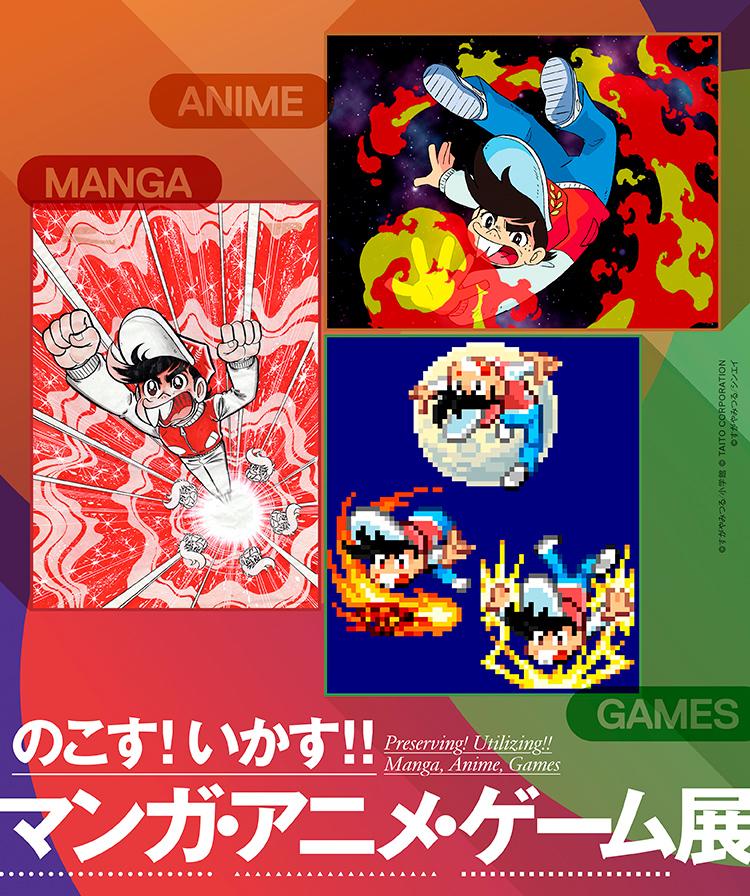
© Mitsuru Sugaya / Shogakukan
© TAITO CORPORATION
© Mitsuru Sugaya /SHIN-EI
Promotion of Media Arts by the Agency for Cultural Affairs: 'Project to Improve Networking and Archival Infrastructure of Media Arts'
Preserving! Utilizing!! Manga, Anime, Games
2024 Nov, 23 (Sat) – 2025 Mar, 31 (Mon)
April, 15*Extend the exhibition period
In recent years, the archival (collection, preservation and utilization) of these materials has been gaining attention along with the great social interest in manga, anime and games.
However, little is known about how these projects are put into practice, or how they support the culture of manga, anime and games.
This exhibition therefore embodies the results of the ‘Project to Improve Networking and Archival Infrastructure of Media Arts’, a promotion of Media Arts by the Agency for Cultural Affairs, to convey the current situation regarding what items have been archived, and in what form, within manga, anime, and games archives. Simultaneously, together with visitors, we will consider what and how items will be collected in the future, in other words, what will be ‘preserved’, how they will be ‘utilized’ in the future, and what the status and significance of this means.
Venue
Kyoto International Manga Museum, 2F Galleries 1, 2, 3.
Admission
Free
* However, a General Admission ticket to the Museum is required
*On Nov 25 (Mon), admission to the museum is free because it is "Kansai Culture Day".
Tickets for same-day admission can be purchased at the ticket vending machine at the entrance.
* Admission tickets can be purchased at the ticket vending machine on the day of your visit or can be pre-purchased online.
Opening hours
10am-5pm (last entry at 4:30pm)
Closed
Every Wednesday; Dec 26 (Thu) to Jan 5 (Sun), and Feb 17 (Mon) to Feb 21 (Fri).
Exhibition structure/Exhibits
A
Exhibition panels and other materials that introduce the efforts being undertaken to archive manga, anime and games as part of the Agency for Cultural Affairs’ project.
B
The exhibition will introduce the processes involved in creating manga, anime and games, from planning, to production and manufacturing, until each work reaches the consumer, along with actual artifacts of production, such as intermediary products that are born out of this process, and the supports and art supplies which are used to make them. This will enable visitors to visualize and experience the vastness of what is included when it comes to ‘archiving popular culture’.
C
We will introduce the initiatives of various groups involved in ‘preservation’ and ‘utilization’, including companies, universities and the artists themselves, in consideration of how to preserve and utilize these archives, and think together with visitors about the future of archival.
Examples of exhibits
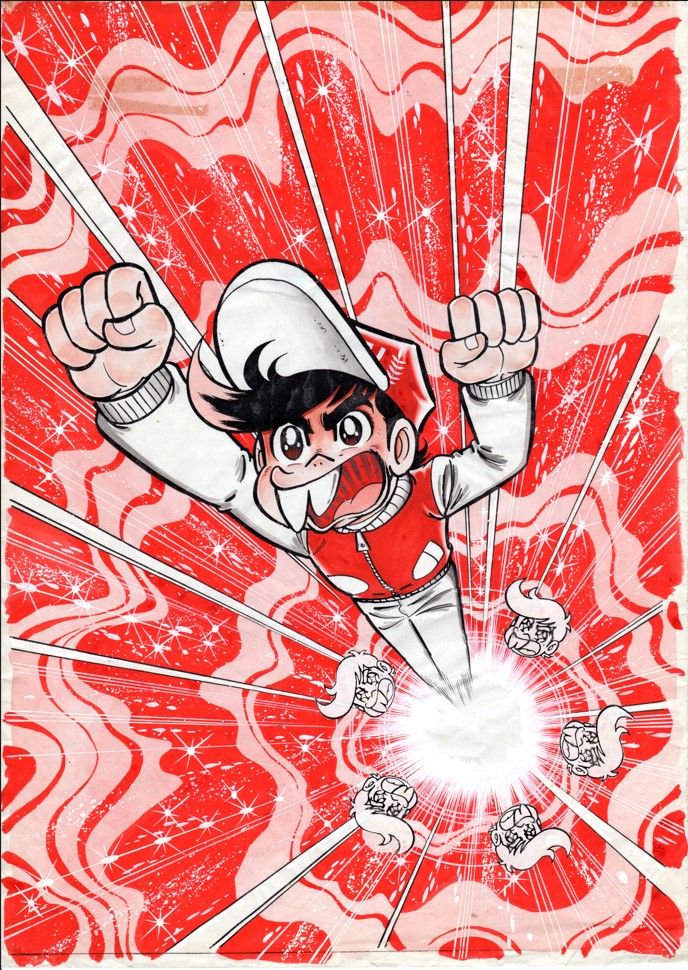
illustration:Sugaya Mitsuru
© Mitsuru Sugaya / Shogakukan
© TAITO CORPORATION
The field of manga
- Various artifacts produced in the process of creating manga and delivering it into the hands of readers.
- Original manga artwork (manuscripts), as well as art materials, drawing tools, storyboards, and rough sketches.
- A ‘manga book’ created by readers by having cut out their favorite manga from magazines and bound them into a volume.
- Initiatives aiming to ‘preserve’ and ‘utilize’ original manga artwork.
- The Genga’(Dash) project, which creates highly detailed reproductions of original artwork, led by artist Takemiya Keiko, the Kyoto Seika University International Research Center, and the Kyoto International Manga Museum.
- The ‘reproduction art’ project by manga artist Hagiiwa Mutsumi, in which she recreates her past works using more durable art materials.
- Original manga artwork by Tanaka Akio, a manga artist who was affected by the Great East Japan Earthquake.
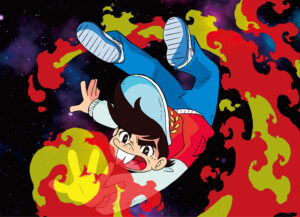
illustration: Mouri Kazuaki
© Mitsuru Sugaya /SHIN-EI
The field of anime
- Opportunities for watching anime and the scope of this exhibition.
- Exhibits showing a closer look at the appeal of original materials, using examples from the anime ‘Wasurenagumo’ (Production I.G).
- Anime planning, from broadcasting to viewing (planning–broadcasting; screening–sales).
- Anime production process
- Detailed explanation of how anime is created (production process).
- Exhibits of example intermediary materials produced as part of the anime production process.
- Exhibit items include storyboards, original artwork, video materials, animation cels, and tracing machinery.
And more.

illustration: Furuya Yukiko
© Mitsuru Sugaya / Shogakukan
© TAITO CORPORATION
The field of games
- The extent of games featured in this exhibition.
- The need for games ‘preservation’
- Characteristics unique to the gaming sector
- Considerations of challenges to dynamically preserving games, and the scope of game preservation.
- The process of games preservation and repair at the Japan Game Museum
- Display showing the difference between a CRT TV and an LCD monitor, showing the demo screen from ‘Pengo’ (Sega).
- Recreation of a scene from ‘Game Center Arashi’
- Space Invaders’ (Taito) on display in playable condition.
Sample images of exhibits
The field of manga
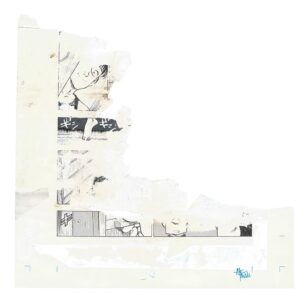
Original manga drawings by Tanaka Akio, a manga artist who was affected by the Great East Japan Earthquake
© KaribuMarei・Tanaka Akio/Futabasha
The field of anime

A tresse machine that transfers lines drawn on paper to a celluloid drawing
(*Photograph is an image only.)
The field of games
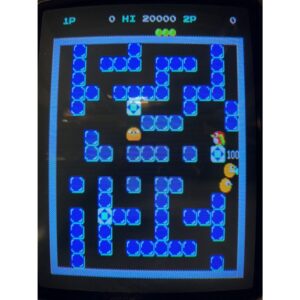
「Pengo」(1982)/SEGA
© SEGA
Why ‘Game Center Arashi’?
Arashi Ishino, the main character of Sugaya Mitsuru's series ‘Game Center Arashi’ symbolizes this exhibition, which is the crossover between manga, anime and games.
‘Game Center Arashi’ is a shonen manga which was serialized in CoroCoro Comic from 1979 to 1983, in which Arashi competes in video games against a successive number of rivals.
Due to its popularity, it was adapted into a TV anime series by Shin-Ei Animation in 1982. Many viewers of the time will remember Arashi's dynamic movements in the anime version of his flashy techniques ‘fire spinning top’ and ‘electric thunder’.
The theme of video games was groundbreaking for a manga before Nintendo's FamiCom console was released in 1983, and on the contrary, several video games adaptations of ‘Arashi’ were created.
Incidentally, it is worth noting that in 1983, when ‘Game Center Arashi’ was awarded the Shogakukan Manga Award in the Children's category, ‘Mai con denji-ran’ began serialization as a follow-up to ‘Arashi’ both of which ran in Bessatsu CoroCoro Comic. ‘Arashi’ portrays the joy of playing an already existing game whereas ‘Ran’ depicts the fun of programming and creating your own game. Another notable work by Sugaya is ‘Konnichiwa maikon’ an educational manga that teaches programming. It was also awarded the Shogakukan Manga Award along with ‘Arashi’ and it has played an important role in the gaming world by “guiding entertainment consumers to become entertainment creators.”
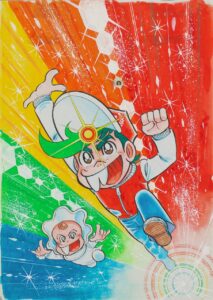
© Mitsuru Sugaya / Shogakukan
© TAITO CORPORATION
Related events
Symposium: How to preserve and utilize manga, anime and Games!!?
Part 1
Members of the Agency for Cultural Affairs Japan Media Arts Archive Project who participate in the fields of manga, anime, and games and who were in charge of the exhibits in each related section of the exhibition will discuss the current and future state of media arts, focusing on the project.
Part 2
Invited guest Sugaya Mitsuru, creator of ‘Game Center Arashi’, a manga series that has also been adapted into an anime, will discuss the opportunities that arise from the intersections of these three fields.
Date and time
2025, Jan 18 (Sat), 12:00-16:00
Venue
Kyoto International Manga Museum, 1F, Multipurpose Hall.
Fee
Speakers
Mitsuru Sugaya (Manga artist)
Shiina Yukari (Agency for Cultural Affairs, Arts and Culture Investigator - Media Arts Division), Ito Yu (Specially Appointed Associate Professor at the Kyoto Seika University International Manga Research Center, and manga section representative for this exhibition), Otsubo Hideyuki (Secretary General of the Japan Animation Creators Association and anime section representative of this exhibition), Obana Takashi (Visiting Researcher at the Ritsumeikan University Game Research Center, and game section representative of this exhibition)
Capacity
200 people (advanced registration required, first come first served)
Participation method
Event day access information
Doors will open from 11:30am. Entry will be admitted in order of the number on your e-ticket.
Please present your e-ticket at the entrance to the venue (1F multipurpose hall). Venue seating is unreserved.
How to access electronic tickets
You can access your ticket by clicking the link “▼ Open ticket” in the ticket reservation receipt email.
If you have a TIGET account, you can also view it from your My Page.
Either way, there is no need to install the smartphone app.
* Registration with the electronic ticket sales service TIGET is optional when purchasing tickets.
Co-organizers: Japan Animation Creators Association (JaniCA), Japan Game Exhibition Association.
Sugaya Mitsuru
Born in Shizuoka Prefecture in 1950. After graduating high school, Sugaya moved to Tokyo and worked in roles such as manga editing production before joining Ishinomori Productions. In 1971, he debuted as a manga artist with ‘Kamen Rider’ in TV Magazine (Kodansha). After that, he worked on the manga versions of ‘Kamen Rider V3’ and ‘Kamen Rider X’. He has many notable works, including ‘Game Center Arashi’ and ‘Konnichiwa maikon’, which won the 28th Sogakukan Manga Award in 1983. He has often tackled new themes that are ahead of their time including computers and computer communications. He completed his master’s degree at Waseda University in 2011 and later worked as a professor in the Manga Department of Kyoto Seika University. He has also authored many works aside from his own manga, and his recent publications include ‘Showa CoroCoro manga bakus? densetsu’ (Bijinesusha) and ‘Manga-ka to manabu chosakken jitsumu nyūmon’ (Jusonbo, edited by Masashi Sawada)

© Mitsuru Sugaya / Shogakukan
© TAITO CORPORATION
Organizers: Agency for Cultural Affairs, Kyoto International Manga Museum, Kyoto Seika University International Manga Research Center, Ritsumeikan University Game Research Center.
Co-organizers: Japan Animation Creators Association (JAniCA), Japan Game Exhibition Association.
Cooperation: Japan Game Museum (Komaki Highway Planning), Osaka Shoin Women's University Beauty Science Center, Sugaya Mitsuru, Shogakukan Shueisha Productions, Taito, Sega, Production I.G., SHIN-EI ANIMATION Co., Ltd., LOPPO, LLC., Anime Tokusatsu Archive Centre
* Please note that the schedule and contents are subject to change.
